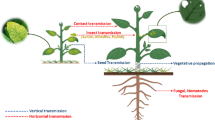Abstract
Five pathogen-host leaf tissue combinations were used to determine whether dried plant disease material gamma (g) irradiated at a level of 25 kGy retains diagnostic value when subjected to selected polymerase chain reactionbased assays. Diagnostic amplification of nucleic acids from all anticipated positive samples was successful following g irradiation. Variability in results is discussed in relation to sample handling.
Similar content being viewed by others
References
Anon. (2009a) Huanglongbing (Citrus greening) (Liberibacter asiaticus). In ‘Pests and Diseases Image Library: plant biosecurity Toolbox’ (PaDIL; Australia). Available at http://www.padil.gov.au [Verified 6 August 2009].
Anon. (2009b) Asiatic Citrus Canker (Xanthomonas axonopodis pv. citri Pathotypes “A”). In ‘Pests and Diseases Image Library: plant biosecurity Toolbox’ (PaDIL; Australia). Available at http://www.padil.gov.au [Verified 6 August 2009].
Cubero J, Graham JH (2002) Genetic relationship among worldwide strains of Xanthomonas causing canker in citrus species and design of new primers for their identification by PCR. Applied and Environmental Microbiology 68, 1257–1264. doi:10.1128/AEM.68.3.1257-1264.2002
Deragon J-M, Sinnett D, Mitchell G, Potier M, Labuda D (1990) Use of g irradiation to eliminate DNA contamination in PCR. Nucleic Acids Research 18, 6149. doi:10.1093/nar/18.20.6149
Drábková L, Kirschner J, Cestmír V (2002) Comparison of seven DNA extraction and amplification protocols in historical herbarium specimens of Juncaceae. Plant Molecular Biology Reporter 20, 161–175. doi:10.1007/BF02799431
Drenth A, Wagels G, Smith B, Sendall B, O’Dwyer C, Irvine G, Irwin JAG (2006) Development of DNA-based method for detection and identification of Phytophthora species. Australasian Plant Pathology 35, 147–159. doi:10.1071/AP06018
Grisoni M, Moles M, Farreyrol K, Rassaby L, Davis R, Pearson M (2006) Identification of potyviruses infecting vanilla by direct sequencing of a short RT-PCR amplicon. Plant Pathology 55, 523–529. doi:10.1111/ j.1365-3059.2006.01397.x
Hocquellet A, Toorawa P, Bové J-M, Garnier M (1999) Detection and identification of the two Candidatus Liberobacter species associated with citrus huanglongbing by PCR amplification of ribosomal protein genes of the b operon. Molecular and Cellular Probes 13, 373–379. doi:10.1006/mcpr.1999.0263
Howlett BJ, Brownlee AG, Guest DI, Adcock GJ, McFadden GI (1992) The 5S ribosomal RNA gene is linked to large and small subunit ribosomal RNA genes in the oomycetes, Phytophthora vignae, P. cinnamomi, P. megasperma f.sp. glycinea and Saprolegnia ferax. Current Genetics 22, 455–461. doi:10.1007/BF00326410
Li W, Levy L, Hartung JS (2009) Quantitative distribution of ‘Candidatus Liberibacter asiaticus’ in citrus plants with citrus Huanglongbing. Phytopathology 99, 139–144. doi:10.1094/PHYTO-99-2-0139
Marie-Jeanne V, Ioos R, Peyre J, Alliot B, Signoret P (2000) Differentiation of Poaceae potyviruses by reverse transcription-polymerase chain reaction and restriction analysis. Journal of Phytopathology 148, 141–151. doi:10.1046/j.1439-0434.2000.00473.x
Matasyoh LG, Wachira FN, Kinyua MG, Thairu Muigai AW, Mukiama TK (2008) Leaf storage conditions and genomic DNA isolation efficiency in Ocimum gratissimum L. from Kenya. African Journal of Biotechnology 7, 557–564.
McNamara NP, Black HIJ, Beresford NA, Parekh NR (2003) Effects of acute gammairradiation on chemical, physical and biological properties of soils. Applied Soil Ecology 24, 117–132. doi:10.1016/S0929-1393(03)00073-8
Shaw K, Sesardic I, Bristol N, Ames C, Dagnall K, Ellis C, Whittaker F, Daniel B (2008) Comparison of the effects of sterilisation techniques on subsequent DNA profiling. International Journal of Legal Medicine 122, 29–33. doi:10.1007/s00414-007-0159-5
Stewart CN, Via LE(1993)ArapidCTABDNAisolation technique useful for RAPD fingerprinting and other PCR applications. BioTechniques 14, 748–749.
Téoule R(1987) Radiation-inducedDNAdamage and its repair. International Journal of Radiation Biology and Related Studies in Physics, Chemistry, and Medicine 51, 573–589. doi:10.1080/09553008414552111
Trampuz A, Piper KE, Steckelberg JM, Patel R (2006) Effect of gamma irradiation on viability and DNA of Staphylococcus epidermis and Escherichia coli. Journal of Medical Microbiology 55, 1271–1275. doi:10.1099/jmm.0.46488-0
Weisberg WG, Barns SM, Pelletier DA, Lane DJ (1991) 16S ribosomalDNA amplification for phylogenetic study. Journal of Bacteriology 173, 697–703.
Author information
Authors and Affiliations
Corresponding author
Rights and permissions
About this article
Cite this article
Jones, L.M., Grice, K.R.E. & Davis, R.I. Gamma irradiation of dried plant material: implications for the identification of plant pathogens employing molecular techniques. Australasian Plant Pathol. 39, 358–362 (2010). https://doi.org/10.1071/AP09093
Received:
Accepted:
Issue Date:
DOI: https://doi.org/10.1071/AP09093




